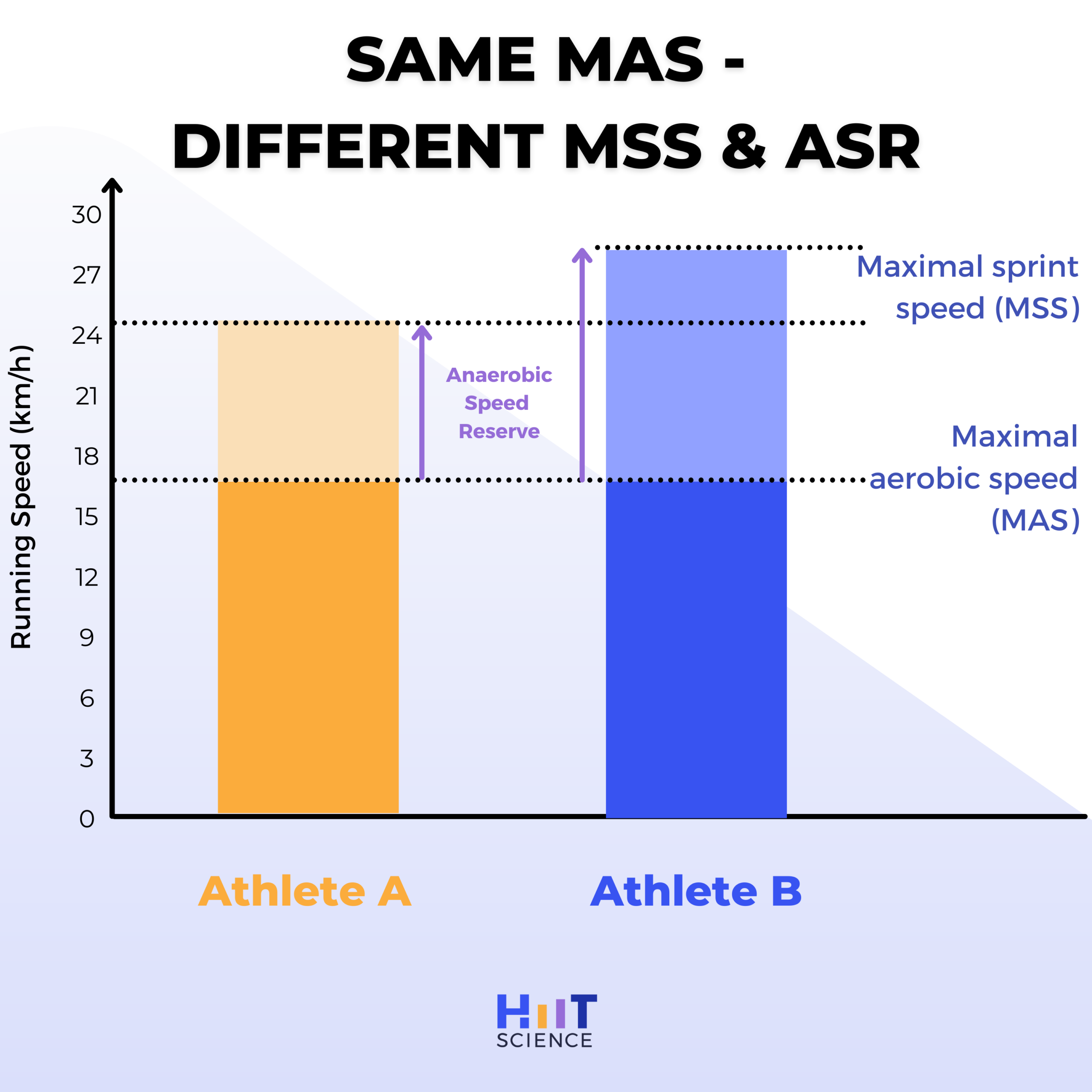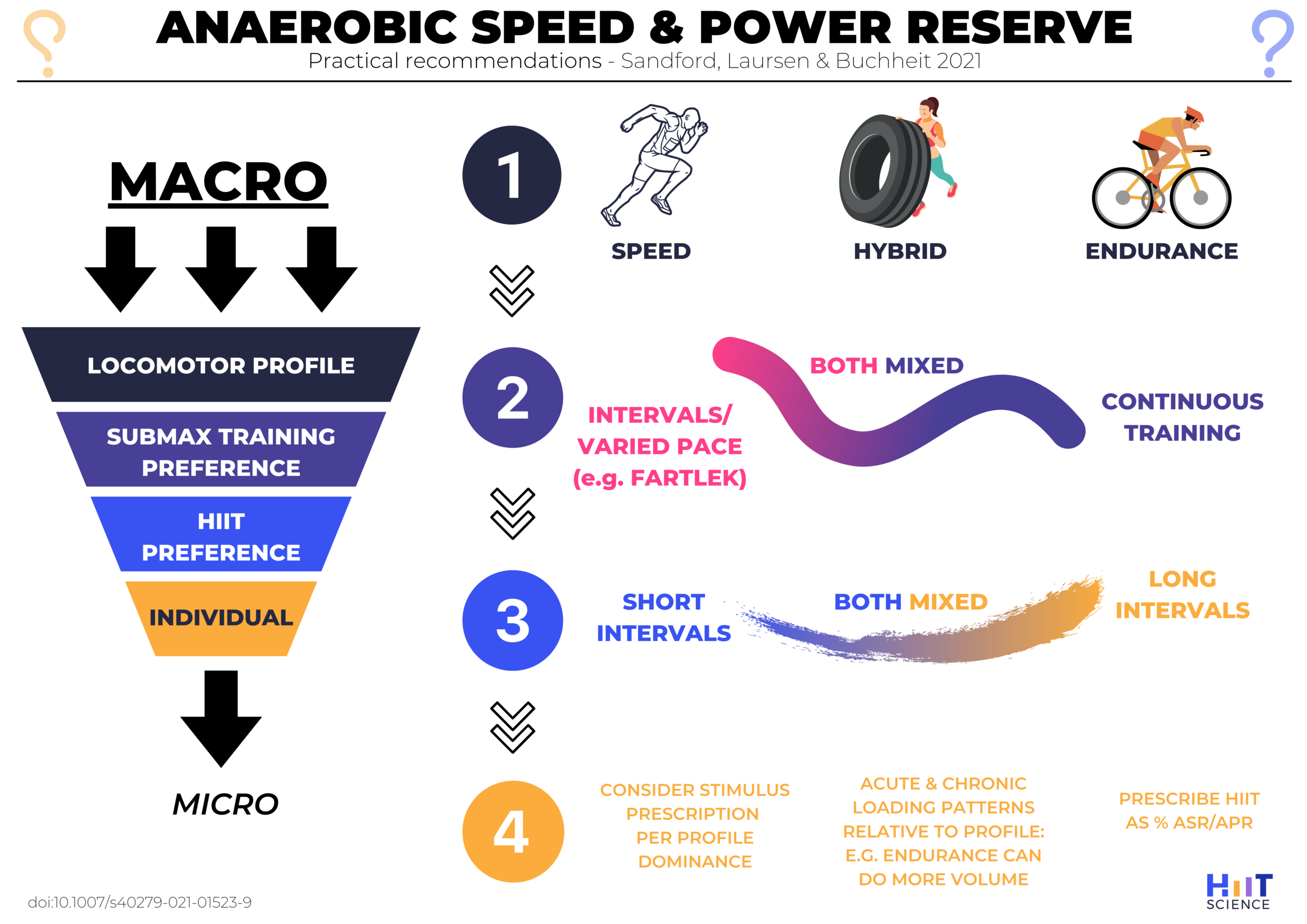Intro and recap of key terminology.
Many individual and team sport events require extended periods of exercise above the speed or power associated with maximal oxygen uptake (i.e., maximal aerobic speed/power, MAS/MAP). In the absence of valid and reliable measures of anaerobic metabolism, the anaerobic speed/power reserve (ASR/APR) concept, defined as the difference between an athlete’s MAS/MAP and their maximal sprinting speed (MSS)/peak power (MPP), advances our understanding of athlete tolerance to high speed/power efforts in this range (1). Figure 1 from HIIT Science below provides a refresher for the reader.

Figure 1: Two athletes with a similar running speed at VO2max can have significantly different sprint speeds. Figure from Buchheit & Laursen (2).
Why athletes with different locomotor profiles should be treated differently
In particular, how differences in underlying athlete profiles (e.g., fiber typology) impact the training response for different ‘speed’, ‘endurance’ or ‘hybrid’ profiles is now emerging (3). Such an individualized approach to athlete training may be necessary to avoid ‘maladaptive’ or ‘non-responses’(4).
Where to begin?
As a starting point for coaches and practitioners, we recommend upfront locomotor profiling using ASR/APR as shown previously (5). The process of locomotor profiling allows you to have discussions in your team about how to best approach training for each of these profiles, rather than operating from one training model that may suit one profile type but be suboptimal for others.

Table 1: Estimated locomotor profile and fibre type continuum for understanding athlete complexity
This process can help guide training content at both the macro (understanding athlete profile variability and training model selection, e.g., annual periodization) and micro levels (weekly daily planning of individual workouts, e.g., short vs long intervals vs repeated sprint training and recovery time between workouts) using principles put forth previously by Lievens and Bellinger (Part 1 & Part 2) (3, 4).
An example application aimed at enhancing aerobic training adaptation is shown in the following Table.
 Table 2: Training stimulus application per sub-group
Table 2: Training stimulus application per sub-group
For example, for a speed profile athlete to develop aerobic adaptations and fatigue resistance they need to recruit and adapt fast twitch muscle. Consequently using short intervals and repeated sprint training (RST) is likely to be a more appropriate approach for this subgroup, and contrasts the potentially more well-known (and endurance profile preference) of long interval prescription that involves effort around MAS/MAP of 2-5 min, with 2-3 minutes of passive recovery (type 4 HIIT). Certain types of HIIT with short intervals 10-15s, 20-30s rest; run at 5-10% ASR type 1 or 2 HIIT) enable substantial time at an intensity near VO2max, while keeping lactate accumulation low (1, 2).
Four aspects that justify the use of RST in speed profiles:
- They tolerate these efforts well as they recruit a high proportion of type ll fibers that have higher levels of baseline buffering and larger glycolytic capability (e.g enzymes).
- They have lower cardiorespiratory fitness levels compared with the endurance-based profile, therefore relying more frequently on anaerobic metabolism, so producing lactate during training is not that different, and they just preferentially use their anaerobic system more.
- Larger muscle fibers (Fast twitch) are associated with lower absolute aerobic energy supply.
- Speed profiles therefore tend to have lower absolute VO2 in prolonged intensity efforts, reducing the relative aerobic stimulus of prolonged efforts vs endurance profiles.
- Therefore aiming to optimize time accumulated at VO2max (TVO2max; traditional approach, endurance type) with a speed type is less fruitful for prescription as opposed to something that is well tolerated (RST) from other perspectives.
- There may be some peripheral acute responses linked to greater deoxygenation levels that can improve aerobic function (at the muscle level) independently of the actual TVO2 of the session.
In addition to better understanding individual locomotor profiles and training stimulus selection, we suggest in support of recent findings (6) that to minimize variability in high-intensity interval training stimulus and adaptation variability, prescription should be tailored to the locomotor profile.
If you prescribe HIIT training beyond MAS, using % maximal aerobic speed, you do not account for differences in mechanical ceiling (the ASR) between individuals. Therefore, the same stimulus applied to two athletes can place different relative stressor. Over time, this may cause a gulf between intended prescription and resulting adaptive responses.
Instead, we recommend to programme workloads beyond MAS as a % of ASR. This normalizes the relative mechanical and associated physiological stimulus, reducing the variability within a squad for a given stimulus. Over time, we believe that this helps to optimize the stimulus to the individual in line with their own individual metabolic (MAS) and mechanical (MSS) ceilings.
A summary of the process that practitioners can follow is outlined below.

Fig. 2: A practical 4 step process for applying the ASR/APR construct across macro & micro training planning perspectives for a squad of diverse athlete profiles
Summary
- From the anaerobic speed/power reserve landmarks representing an athlete’s maximal mechanical capability (MSS/MPP) and speed or power at maximal aerobic capacity (MAS/MAP), coaches and practitioners can identify the diversity of profiles in their training group.
- Different profiles respond differently to different stimulus. A mismatch between prescription and athlete profile can lead to maladaptation or non-response
- For HIIT programming of workloads beyond MAS/MAP, we recommend using % ASR. This normalizes the relative mechanical and associated physiological stimulus to the athletes own individual ceilings.
- Over time, this may improve the gulf between intended prescription and resulting adaptive responses across a diversity of athlete profiles by tailoring prescription and training decisions to a locomotor profile sub-group perspective.
About the author
Dr. Gareth Sandford completed his PhD on the topic of the Anaerobic Speed Reserve in 2018. Gareth was scientific lead for Athletics Canada at the Olympic marathon and race-walk location, Tokyo 2021 Olympic Games and is currently a sport physiologist at the Canadian Sport Institute Pacific.
Twitter: @Gareth_Sandford
Researchgate: https://www.researchgate.net/profile/Gareth-Sandford
- Sandford, GN, Laursen, PB, Buchheit, M Anaerobic Speed/Power Reserve and Sport Performance: Scientific Basis, Current Applications and Future Directions, Sports Med, 2021, Online ahead of print
- Buchheit, M. and Laursen, PB High-intensity interval training, solutions to the programming puzzle: Part I: cardiopulmonary emphasis. Sports Med, 2013. 43(5): p. 313-338.
- Lievens E, Klass M, Bex T, and Derave W. Muscle fiber typology substantially influences time to recover from high-intensity exercise. Journal of Applied Physiology 128: 648-659, 2020.
- Bellinger P, Desbrow B, Derave W, Lievens E, Irwin C, Sabapathy S, Kennedy B, Craven J, Pennell E, Rice H, and Minahan C. Muscle fiber typology is associated with the incidence of overreaching in response to overload training. Journal of Applied Physiology doi.org/10.1152/japplphysiol.00314.2020
- Sandford GN, Allen SV, Kilding AE, Ross A, Laursen PB. Anaerobic Speed Reserve: A Key Component of Elite Male 800-m Running. Int J Sports Physiol Perform. 2019 Apr 1; 14(4):501-508. doi: 10.1123/ijspp.2018-0163. Epub 2019 Mar 4. PMID: 30300023.
- Collison J, Debenedictis T, Fuller JT, Gerschwitz R, Ling T, Gotch L, Bishop B, Sibley L, Russell J, Hobbs A, Bellenger CR. Supramaximal Interval Running Prescription in Australian Rules Football Players: A Comparison Between Maximal Aerobic Speed, Anaerobic Speed Reserve, and the 30-15 Intermittent Fitness Test. J Strength Cond Res. 2021 Aug 11. doi: 10.1519/JSC.0000000000004103. Epub ahead of print. PMID: 34387223






